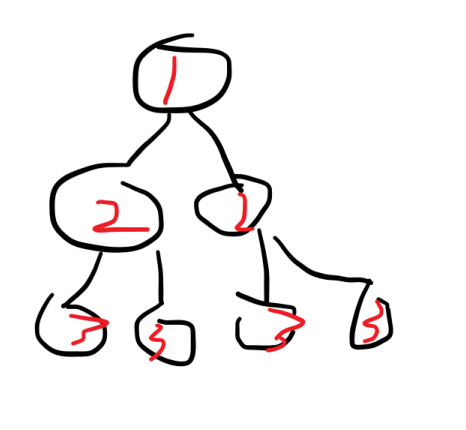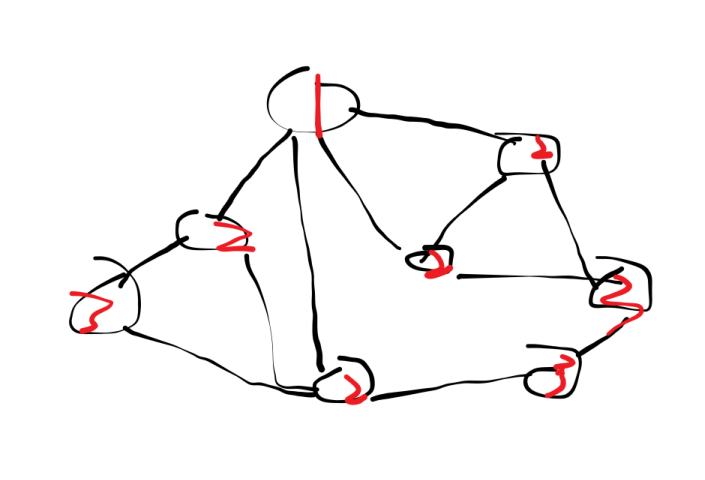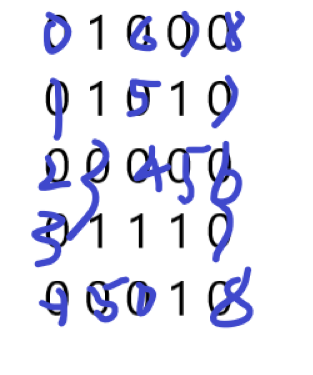bfs
同步视频:
bfs
bfs的全称是宽度优先搜索,也叫广度优先搜索,是一种与队列紧密结合的搜索。
比如我们便利一下下面的搜索树。
红色表示搜到的点的层次。

我们可以发现,宽搜是用我们一层一层的搜索构成的。
那我们就可以用队列存储我们搜索到了啥。
然后我们看一下bfs对图的便利好理解下一期的bfs求最短路。

还是一样,图中红色的点表示搜的顺序。
接着我们来复习一下队列。
这里是队列的讲解~
初始化:
int q[N], hh = 0, tt = -1;
插入操作:
q[ ++ tt] = x;
删除操作:
hh ++;
判断队列是否为空:
hh <= tt
获取:
cout << q[hh] << endl;
以及这里要用到的弹出队头:
auto t = q[hh ++];
接下来我们来说一说宽搜的框架。
其实很弱啊。。。
while(hh <= tt /*队列不空*/)
{
auto t = q[hh ++];//弹出队头。
//也可以写成STL版的:
/*
auto t = q.front();
q.pop();
*/
//拓展队头
//……
}
来道题:走迷宫
本题可以刚好用DFS来做。
这是层次图:

我们可以这样用d数组存每个点到起始点的距离。
好那条件就是:
1. d[x][y] == -1;//-1表示没走过
2. g[x][y] == 0;
那搜索就来了。
但这里我们拓展队头时不用写四个判断。
我们可以用数组来实现,具体如下:
int dx[4] = {-1, 0, 1, 0}, dy[4] = {0, 1, 0, -1};
然后for循环即可。
分段代码:
1.main:
int main()
{
cin >> n >> m;
for(int i = 0; i < n; i ++)
for(int j = 0; j < m; j ++)
cin >> g[i][j];
cout << bfs() << endl;
return 0;
}
2、bfs准备:
int bfs()
{
memset(d, -1, sizeof d);
d[0][0] = 0;
q[0] = {0, 0};
int hh = 0, tt = 0;
/*
int hh = 0, tt = -1;
q[ ++ tt] = {0, 0};
*/
int dx[4] = {-1, 0, 1, 0}, dy[4] = {0, 1, 0, -1};
}
3、框架:
while(hh <= tt)
{
auto t = q[hh ++];
}
4、拓展队头:
for(int i = 0 ; i < 4; i ++)
{
int x = t.first + dx[i], y = t.second + dy[i];
if(x >= 0 && x < n && y >= 0 && y < m && d[x][y] == -1 && g[x][y] == 0)
{
d[x][y] = d[t.first][t.second] + 1;
q[ ++ tt] = {x, y};
}
}
5、return
return d[n - 1][m - 1];
完整代码:
#include<bits/stdc++.h>
using namespace std;
const int N = 1100;
int n, m, g[N][N], d[N][N];
pair<int, int> q[N * N];
int bfs()
{
memset(d, -1, sizeof d);
d[0][0] = 0;
q[0] = {0, 0};
int hh = 0, tt = 0;
int dx[4] = {-1, 0, 1, 0}, dy[4] = {0, 1, 0, -1};
while(hh <= tt)
{
auto t = q[hh ++];
for(int i = 0; i < 4; i ++)
{
int x = t.first + dx[i], y = t.second + dy[i];
if(x >= 0 && x < n && y >= 0 && y < m && d[x][y] == -1 && g[x][y] == 0)
{
d[x][y] = d[t.first][t.second] + 1;
q[ ++ tt] = {x, y};
}
}
}
return d[n - 1][m - 1];
}
int main()
{
cin >> n >> m;
for(int i = 0; i < n; i ++)
for(int j = 0; j < m; j ++)
cin >> g[i][j];
cout << bfs() << endl;
return 0;
}


void bfs(int u,int dist)//dist表示当前遍历到的顶点到u的距离 { queue<int> q; q.push(u); while(q.size()) { int t=q.front(); st[t]=true; q.pop(); for(int i=h[t];i!=-1;i++) { int j=e[i]; int k=w[i]; if(!st[j]) continue; q.push(j); dist=max(dist,dist+k); } } }大佬能不能用bfs求出在树中距离1号点距离最远的点啊
下一期哦
感谢👏👏